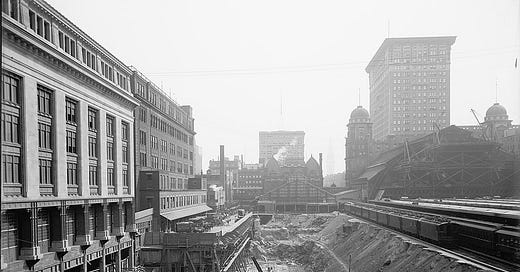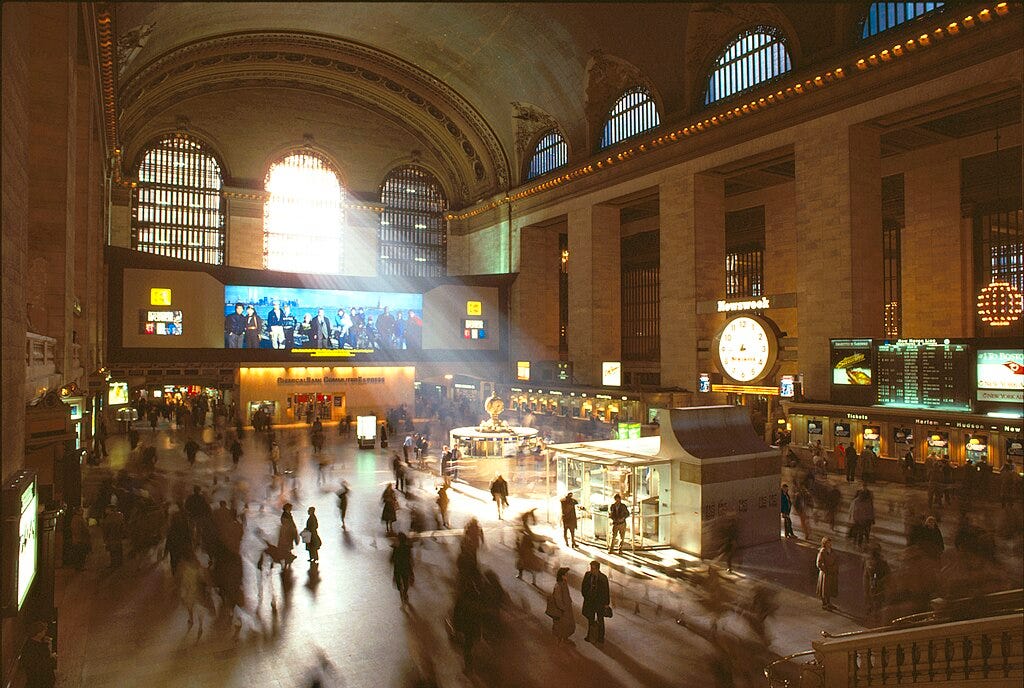Policy wonks use the phrase “wicked problem” to describe an interlinked nest of dilemmas that resists all straightforward solutions. Although the phrase hadn't been coined in 1902, it would have been a good label for a crisis gathering at the railroad terminal at 42nd Street in Midtown Manhattan.
Even so, regulators, engineers, and the New York Central Railroad came together to craft a world-class solution. And it wouldn't have happened without an unreasonable man, a brilliant and self-taught engineer by the name of William J. Wilgus.
As of New Year's Day in 1902, Grand Central Station was the principal railroad station in Manhattan. Traffic was growing by the year but there wasn’t room to squeeze in even one more track outside the building or another platform inside. While the big ground-level rail yard cut apart the neighborhoods and the steam engines showered the neighborhoods with ash, New York Central refused to do any more than renovate its station to pack in more passengers. The station was profitable but posed many risks to passengers, trainmen, and nearby residents.
This standoff ended on January 8, 1902, when one steam engine in a tunnel leading to the station smashed into another train that had stopped. The incoming train’s engineer couldn't see the danger signal through the dense smoke and steam. City papers covered the fatalities in horrifying detail, and the New York City Council, working with the state legislature, ordered that operations at the station shift from steam power to electric traction. The city gave the railroad five years to finish the job.
At this early stage, just making a fast switch from steam to electric power promised a huge headache. Certainly no reasonable person could have expect the railroad to triple its workload by choosing to tear down Grand Central Station (which had been completely renovated only two years before). And to rip up the half-mile long rail yard to the north so it could be put into a big hole. And to restore the streets.
And to keep daily rail traffic moving even as the station was torn down and rebuilt.
Fortunately for posterity, William Wilgus was simultaneously unreasonable and pragmatic. Born in Buffalo in 1865, he had risen to the position of chief engineer and vice president of the sprawling Vanderbilt-owned railroad network.
In one remarkable September afternoon, eight months after the rail disaster, Wilgus sat down at his desk and listed all the biggest problems facing the railroad and its station. In a few hours, with one Eureka moment after another, he arrived at an elegant solution: not just a win-win, but a win-win-win.
Wilgus started with the bitter fact that government was forcing the railroad to do something it hadn't wanted to do: shift quickly from steam to electrical power. While that seemed a bad thing for the railroad's bottom line – don't Ayn Randians tell us that all government mandates are outrageous? – Wilgus saw that shifting to electric power might be a good thing. Maybe a great thing.
Why? Electric power opened up entirely new options. One option was putting buildings on beams over the rail yard, since the occupants wouldn't be smoked out by steam engines. But why not sink the rail yard below street level and put the new buildings at street level instead? Wilgus realized that if he took the rail yard deep enough to split the underground rail traffic into two levels, and added loops around the new station, this would greatly improve the traffic flow. Before the sun set that day, Wilgus drew a plan that would meet the government deadline, more than double the station’s passenger capacity, transform midtown Manhattan, and turn a liability to an immensely valuable asset.
Wilgus advised the railroad executives that if they erected stout steel columns and beams between the sunken tracks, these would form a foundation for skyscrapers above the rail yard, standing along Park Avenue. Land developers would pay to construct the buildings but write annual rent checks to the railroad, which would cover costs at the new Grand Central Terminal.
The excavation required blasting a pit as much as 70 deep, which brought a bit of the Panama Canal into midtown New York. The excavation proceeded one “bite” at a time, moving from Lexington Avenue on the east to Madison on the west. This required tearing up the permanent track, stripping away the soil to expose the bedrock gneiss and schist of Manhattan Island, so they could blast it loose.
(Credit: Library of Congress)
The pit then filled with massive and complex steelwork to support the two-layer track, along with the rebuilt streets above. All told the railroad created 15 acres of artificial ground over the hidden rail yard, propping pavement and sidewalks and trees atop two miles of steel framing.
Wilgus resigned in 1907 after a dispute with the railroad, but before leaving he helped devise a system of ramps, service windows, and rooms that separated commuters from long-distance travelers, and those arriving from those leaving. It eased the pedestrian flow so well that people-moving solutions crafted at Grand Central can be seen at malls and airports today.
The new terminal opened just after midnight on February 2, 1913, to much fanfare. Even as rail traffic diminished after World War II, it survived each economic crisis because New Yorkers valued its beauty above ground and efficiency underground.
(Credit: MTA)
So, when visiting Manhattan, look beyond the magnificent building at street level and see the deeper lessons. The usual way to tackle a wicked problem is to use conventional approaches like a direct attack with legislation that fills in all the unhappy details; or that tries to and buy out the problem with huge public subsidies. Grand Central, that miracle at 42nd Street, suggests that sometimes we need the unreasonable.
When I was in law school we studied the “reasonable person” standard and that's fine for Contracts and Criminal Law, but I like to think of Grand Central Terminal was a triumph of unreasonable people. That includes William Wilgus in proposing such an impossibly big job, the railroad for going so far beyond the city's mandate in restoring the neighborhood and building a monument for the ages, and the city in working closely with the railroad to make the magic happen.






